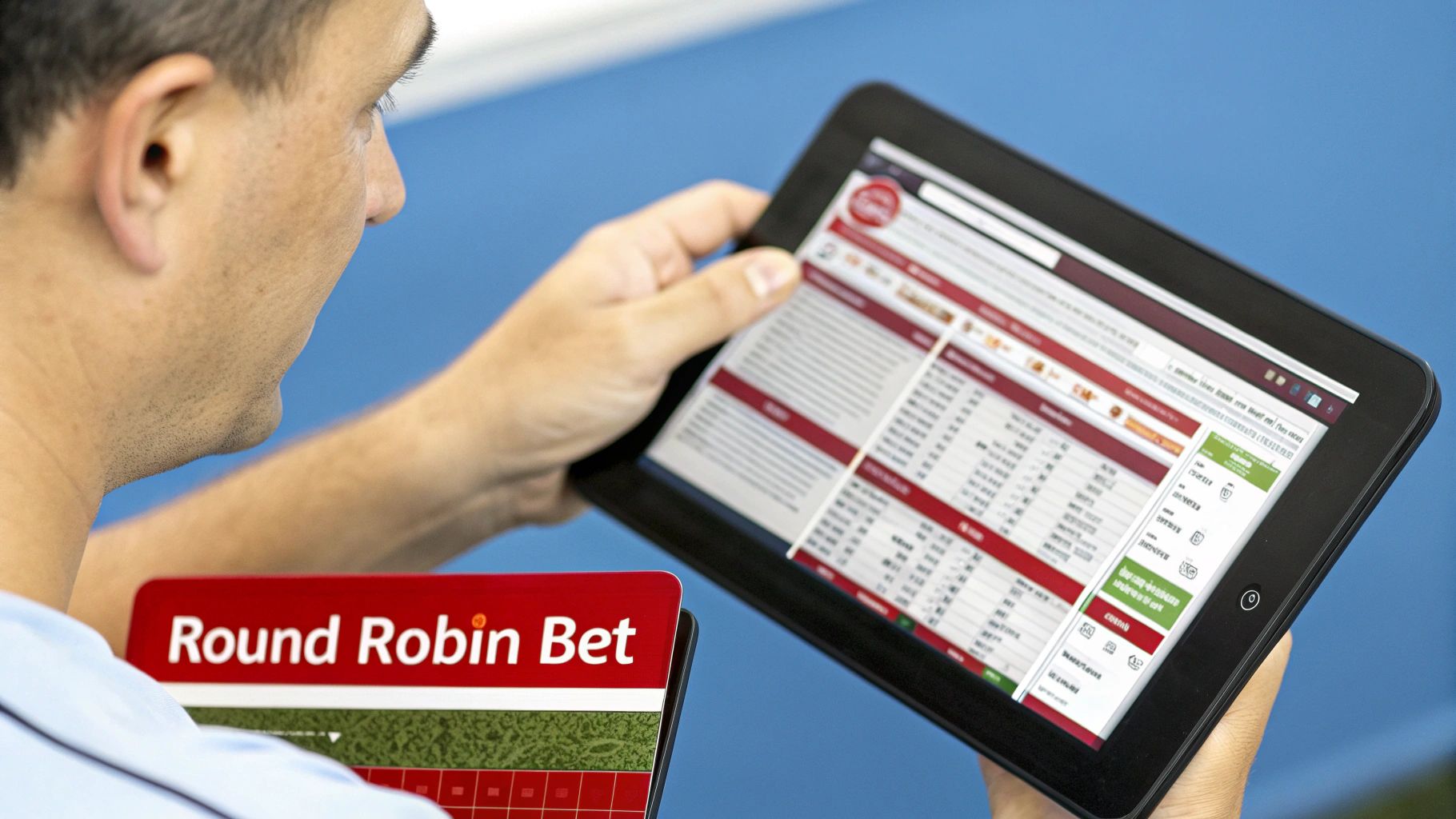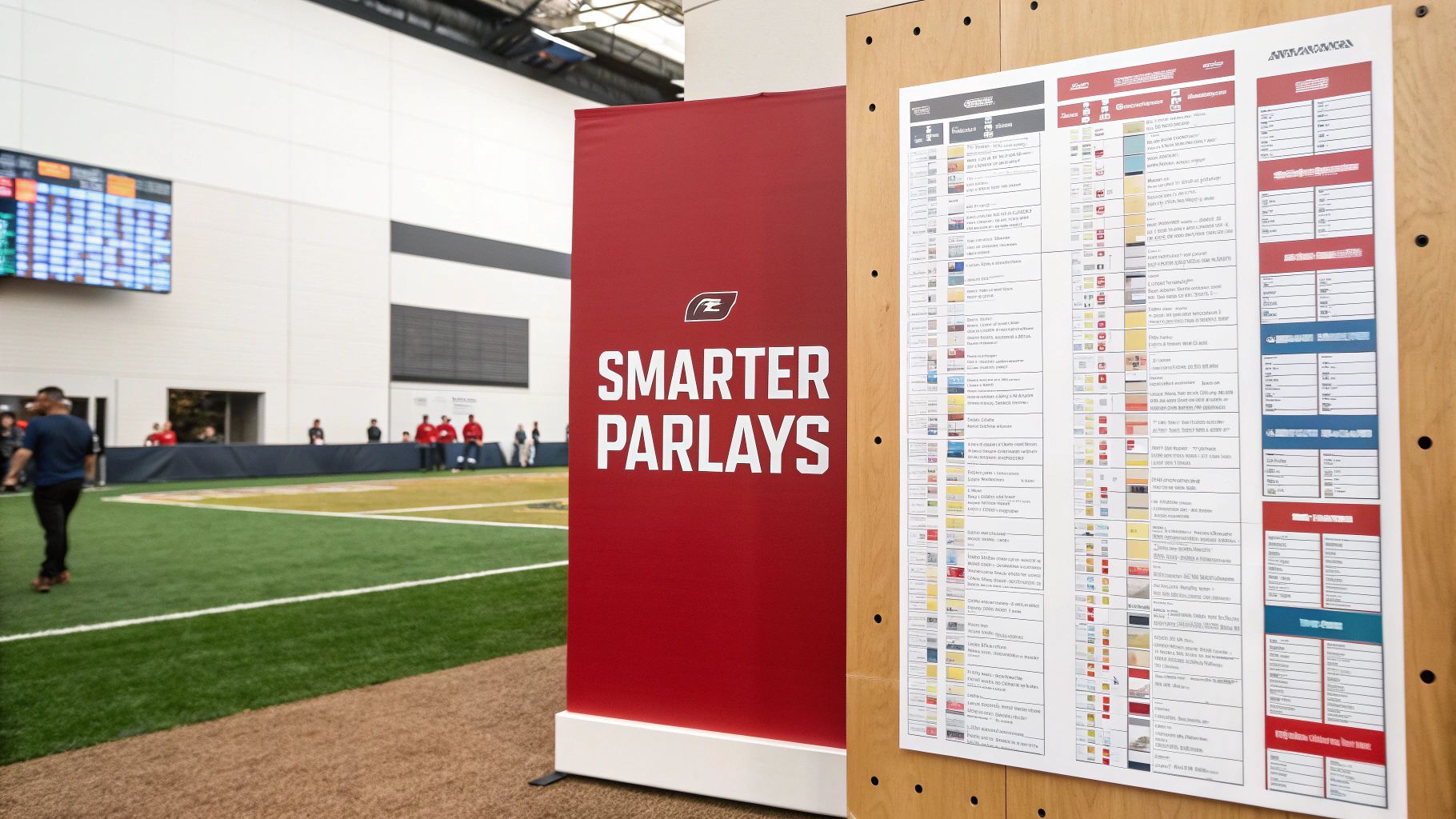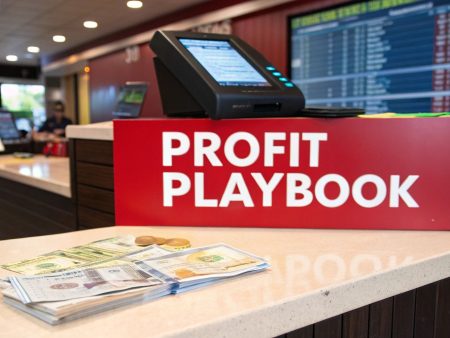A round robin bet is basically your insurance policy for parlays. Instead of lumping all your picks into one make-or-break wager, it cleverly slices them into multiple smaller parlays. This gives you a fighting chance to cash a ticket even if one leg of your bet goes sideways. It’s a smart way to add a safety net when you’re staring down a single upset that could otherwise wreck your whole slip.
What Is a Round Robin Bet
We’ve all been there. You’ve done the research, you feel great about a handful of games over the weekend, but there's that nagging feeling that one unexpected result could ruin everything. That’s exactly where the round robin comes in to save the day.
Think of it as an automatic risk-management tool. You feed it your list of teams or players, and it creates a web of smaller parlays for you. Most of the big offshore sportsbooks, like BetOnline and Bovada, have this built right into their bet slips, making it super easy to set up.
The real beauty of this strategy is the cushion it provides. You no longer need a perfect record to get paid. A round robin lets you collect a return even if one of your picks doesn't hit, striking a nice balance between the high-risk, high-reward rush of a traditional parlay and the safer, smaller payouts of single bets.

Core Concepts Explained
The concept is surprisingly simple but incredibly effective. When you place a round robin, you aren't making one giant bet; you're placing a series of smaller, interconnected ones. It’s the perfect approach for managing your risk while still chasing a decent payday.
Of course, before you jump in, you absolutely have to know how to read betting odds. This is non-negotiable, as it’s the only way you’ll understand your potential returns and make sharp decisions.
For a quick reference, here are the core ideas behind a round robin bet.
Round Robin Bet Quick Facts
| Concept | Explanation |
|---|---|
| Structure | A single bet that automatically creates multiple smaller parlays from your selections. |
| Purpose | To provide a safety net; you can still win money even if one of your picks loses. |
| Risk Level | Sits between a high-risk standard parlay and a low-risk single wager. |
| How It Works | Example: 3 teams are broken into 3 separate 2-team parlays. |
| Payout Potential | Lower maximum payout than a standard parlay but a higher chance of a return. |
Essentially, it’s all about giving yourself more ways to win.
Let's walk through a quick example. Say you pick three NFL teams on a Sunday at an offshore site like Cosmobet. A round robin automatically creates three separate two-team parlays from those picks. If you bet $5 on each of those three parlays (for a $15 total stake) at standard -110 odds and all three teams win, your total return is $54.
But here's the magic: if just one team loses, you still win one of your two-team parlays. That would net you a profit of around $8. In the same scenario, a standard three-team parlay would have been a total loss. This shows you exactly how a round robin provides that valuable middle ground for bettors.
A round robin provides built-in insurance. It’s designed for bettors who feel confident in multiple outcomes but want to protect themselves from the unpredictability that can derail a perfect parlay.
Alright, let's get into the nitty-gritty of actually placing a round robin. The theory is great, but now it's time to put your money where your mouth is.
How to Place Your First Round Robin Bet
Putting your first round robin bet down is way easier than you might think. If you’ve ever placed a regular bet or a parlay, you’re already 90% of the way there. Most of the top offshore sportsbooks like MyBookie or BetUS make the process incredibly smooth.
Let’s walk through a classic scenario: a busy NFL Sunday. You've done your homework and feel really good about three specific moneyline picks.
- Kansas City Chiefs to win
- Buffalo Bills to win
- San Francisco 49ers to win
You’d head over to a site like Sportsbetting.ag, navigate to the NFL odds, and just click the moneyline for each of those three teams. As you click, they’ll pop up in your bet slip, just like any other wager.
Finding the Round Robin Option
This is where the magic happens. Once your picks are loaded into the bet slip, you'll see the usual options for single bets and standard parlays. Instead of putting your stake in the parlay box, you need to look for a separate tab or link. It’s usually labeled 'Round Robin' but sometimes you might see it called 'If Bets/Reverse.'
This screenshot from Sportsbetting.ag shows you exactly what to look for. Notice how after you add your teams, the slip neatly organizes all the different ways you can bet on them.

It’s all right there. No need to hunt around.
Structuring Your Bet
Once you click into the round robin section with your three teams selected, the sportsbook will ask how you want to break them down. You’ll see options like "By 2's" and "By 3's." This is just asking how many teams you want in each of the smaller parlays.
- By 2's: This is the most common choice. It creates every possible 2-team parlay combination from your picks. With three teams, that means you're creating 3 separate 2-team parlays.
- By 3's: This is just a single 3-team parlay, essentially the same as a standard accumulator bet.
Here's the one thing that trips up new bettors: how your stake is calculated. If you put $10 in the box next to "By 2's" for a 3-team round robin, your total risk is not $10. It’s $30. That’s because you're placing a $10 bet on each of the three individual 2-team parlays.
Your total wager is simply your stake per parlay multiplied by the number of parlays created. This is crucial to remember so you don't accidentally bet more than you intended.
Thankfully, good sportsbooks like Bovada and Bookmaker.eu do the math for you. They’ll show your total stake clearly before you hit confirm, so there’s no guesswork. Once you've set your amount, confirmed the structure, and hit that 'Place Bet' button, you're all set. You've just placed a smarter, more strategic wager that gives you a safety net against that one bad beat.
Calculating Your Potential Payouts
Figuring out what you stand to win is, without a doubt, the most important part of placing any bet. At first glance, the math behind a round robin might look a bit intimidating, but it’s really just a bunch of simple parlay calculations bundled together. The key is to stop thinking of it as one massive wager and see it for what it is: several smaller, interconnected bets.
This video breaks it down pretty well:
To get a real feel for it, let's walk through a practical example. Say you're betting on the NFL at a site like Bookmaker.eu. You've picked out four teams you feel good about, all with standard -110 odds. You decide to structure your round robin using two-team parlays, putting $10 on each one.
With four teams, you're creating a total of six separate two-team parlays. This means your total risk for this bet is $60 ($10 x 6 parlays).
The Best-Case Scenario: All Picks Win
Let's start with the dream—all four of your teams come through and win their games. This is the grand slam, the scenario that delivers your maximum possible payout.
Here’s how it looks:
- Parlay 1 (Team A + Team B): Winner!
- Parlay 2 (Team A + Team C): Winner!
- Parlay 3 (Team A + Team D): Winner!
- Parlay 4 (Team B + Team C): Winner!
- Parlay 5 (Team B + Team D): Winner!
- Parlay 6 (Team C + Team D): Winner!
A standard two-team parlay with -110 odds turns a $10 bet into a $26.45 payout. Since all six of your parlays hit, your total return is a sweet $158.70 (6 x $26.45). After you subtract your initial $60 stake, you're left with a clean profit of $98.70. Not bad at all for a day's work.
A Realistic Outcome: Three Out of Four Win
Now, let's get a little more realistic. It's tough to go a perfect 4-0. What happens if one team lets you down? Let's say Teams A, B, and C all win, but Team D drops the ball.
This is where the round robin really shows its value. Any parlay that included the losing Team D is now dead. But the parlays made up of your three winners are still very much alive.
- Parlay 1 (Team A + Team B): Winner!
- Parlay 2 (Team A + Team C): Winner!
- Parlay 4 (Team B + Team C): Winner!
- Losing Parlays: The three parlays that included Team D are toast.
You still cashed three of your six tickets. Your total return comes to $79.35 (3 x $26.45). Once you factor in your $60 cost, you still walk away with a $19.35 profit. Think about that for a second. If this had been a standard four-team parlay, that one loss would have wiped out your entire $60 stake. Instead, you still made money.
The core benefit of a round robin is its resilience. It's designed to absorb a loss and still give you a chance to end up in the black, a feature that traditional parlays simply can't offer.
Recovering Your Stake: Just Two Picks Win
Finally, what happens on one of those really tough Sundays where you only hit half your picks? Let's say Team A and Team B get the win, but Teams C and D both fail to cover.
In this situation, only one of your six parlays has a shot. The single ticket combining Team A and Team B is a winner, paying out $26.45.
Since your total investment was $60, you end up with a net loss of $33.55. Nobody likes losing, but you clawed back almost half of your initial stake. With a regular parlay, that same 2-2 record means your entire $60 would have been gone. This damage control is a huge part of the round robin's appeal.
Getting a handle on these payout dynamics is crucial, and you can dig even deeper into parlay mechanics in our guide to Bovada parlays.
Why Round Robins Outsmart Traditional Parlays
When you're staring at a parlay and a round robin, it's a bit like choosing between a high-wire act with no safety net and one with a sturdy one below. Both dangle the promise of a big payday, but only the round robin gives you a fighting chance to survive a slip-up. That strategic cushion is exactly why sharp bettors often lean this way instead of going for the all-or-nothing parlay.

The main advantage boils down to one thing: smart risk management.
Picture this: you've pieced together what feels like a bulletproof 5-team parlay on a site like Xbet. You’re confident in every single pick, but let's be real, sports are famously unpredictable. If just one of those teams has an off night and fails to cover, your entire parlay ticket is toast. Your stake? Gone. It’s a brutal outcome every single bettor has felt before.
A round robin completely changes that painful scenario. Instead of one massive bet, your five selections are automatically spun into ten separate 2-team parlays (or ten 3-team parlays, depending on how you structure it). So when that one inevitable upset happens and you finish 4-1, you don't walk away with nothing.
Quite the opposite, actually. You cash six of your winning 2-team parlays, very likely turning a profit and saving your bankroll from a total loss.
The Statistical Edge Over All-Or-Nothing Bets
This isn't just about feeling safer; it’s a numbers game. Round robin bets give you a statistically better shot at seeing a return by breaking one massive, improbable bet into several smaller, more winnable ones.
Think about the odds. A simple two-leg parlay might have a 27.44% chance of hitting, which is already a challenge. But a five-leg parlay? The probability of success craters to just 3.94%. By splitting up your picks, the round robin lets you cash in on multiple combinations even if a clean sweep doesn't materialize. It’s a simple way to lower your overall risk. You can dig deeper into these kinds of betting strategies to really sharpen your approach.
A round robin bet is the perfect tool for bettors who are confident in a slate of games but realistic enough to know that perfection is rare. It’s about building a wager that can withstand a single unpredictable upset.
Unlocking Extra Value
Beyond just the built-in safety net, this style of betting can also squeeze out extra value, especially if you’re using offshore sportsbooks. Some platforms, like BUSR or BetAnything, might run promotions or serve up unique odds that make these wagers even more attractive.
By framing your picks as a series of smaller parlays, you simply create more ways to win. This approach flips a high-risk gamble into a calculated strategy. It makes the round robin an essential tool for any bettor trying to build a more resilient—and potentially more profitable—betting portfolio. It’s just a smarter way to chase those big returns without exposing yourself to the catastrophic heartbreak of a single bad beat.
When to Use a Round Robin Betting Strategy
A round robin isn't some magic formula you can apply to every bet slip. Far from it. Its real power comes from knowing the right time to pull it out of your toolkit. Think of it as a specialized play for high-opportunity moments, especially when you feel strongly about several games but want to hedge against that one shocking upset that blows up a traditional parlay.
Picture a full Sunday slate of NFL games or a weekend packed with Premier League matches. You’ve done your homework and identified three or four heavy favorites you’re confident will get the job done. Instead of lumping them all into one high-risk parlay, a round robin lets you spread that risk out. Even if one underdog pulls off a miracle win, your other combinations can still cash, potentially saving your day or even turning a profit. It’s a classic application of the strategy you’ll see used on sites like Bet105 and Cosmobet.
Leveraging Underdogs for Maximum Payout
But it's not just about playing it safe with favorites. The other side of the coin is where things get really interesting. Round robins can be incredibly powerful when you sprinkle in a few well-researched underdogs. While betting on favorites provides that safety net, mixing in some longshots is how you chase those massive payouts.
Let’s say you’ve spotted three underdogs with some seriously juicy moneyline odds.
- You’ve got a good feeling about them, but let’s be real—the chances of all three winning are pretty slim.
- By placing a round robin, you only need one of your two-team parlays to hit to potentially see a huge return.
- This approach turns a longshot gamble into a calculated play with multiple ways to land a big score.
A round robin is at its best when your confidence in multiple picks is high, but you’re realistic enough to know that sports are wildly unpredictable. It's a bet that respects the fact that perfection is rare.
Aligning Strategy with Your Betting Style
Ultimately, deciding whether to use a round robin comes down to your own risk tolerance and betting goals. If you're a more conservative bettor focused on grinding out small, consistent wins, this could be the perfect tool to add to your arsenal. It’s a method that fits perfectly within a structured, disciplined approach to wagering.
This is where having a solid game plan becomes essential. The higher upfront stake of a round robin demands careful planning and a clear head. To get a better handle on managing your funds for these kinds of wagers, check out our guide on sports betting bankroll management. It’s the key to using this strategy for long-term success without getting in over your head.
Common Round Robin Mistakes to Avoid
A round robin can be an incredible tool in your betting arsenal, but it's not foolproof. I've seen plenty of bettors turn what should have been a smart, strategic wager into a costly mistake. Let's walk through some of the most common tripwires so you can steer clear of them on platforms like MyBookie and BetUS.
The biggest and most frequent error? Getting greedy. It's so tempting to load up a ticket with a bunch of teams, thinking you're casting a wide net. But the reality is, as you add more teams, the cost of your bet explodes exponentially.
An 8-team round robin looks great on paper until you see the final price tag. If you structure that into 2-team parlays with just a $5 unit stake, you're suddenly risking $140. That’s because you’ve created 28 individual parlays. At that point, you have to win almost every single leg just to break even, let alone turn a profit.
Forgetting That Odds Are King
Another classic blunder is tunnel vision on wins and losses, completely ignoring the odds. Newcomers often think that as long as a few of their mini-parlays hit, they're in the money. That's a dangerous assumption.
Imagine you build a round robin full of heavy moneyline favorites—teams juiced to -300 or -400. The payouts on those two-team parlays will be tiny. It's shockingly easy to cash more than half your tickets and still end up with a net loss because the small wins don't come close to covering the cost of your losers.
Always do the math before you hit "confirm." A ticket that says "WIN" is not the same as a profitable ticket. If the odds are too short, you're just spinning your wheels.
Dropping the Ball on Bankroll Management
This one's crucial. A round robin's upfront cost can be deceptive. Treating a $10 unit stake on a round robin like a simple $10 bet is a fast track to draining your account.
You have to look at the total risk, which offshore sportsbooks like Bovada and Bookmaker.eu will clearly show you before you place the bet. That $10 wager could actually be a $30, $60, or even larger commitment from your bankroll. Always, always double-check that total stake.
The global sports betting market is ballooning—projected to hit USD 100.9 billion in 2024—and complex bets like round robins are a big reason why. As more people dive into strategic wagering, as detailed in market analysis from places like Grand View Research, betting smart is more important than ever. Don't let these simple mistakes trip you up.
Round Robin Betting FAQs
Even with a solid grasp of how round robins work, a few questions always seem to pop up. Let's tackle the most common ones head-on to clear up any lingering confusion before you start building your tickets.
What Is the Difference Between a Round Robin and a Trixie Bet?
Think of a Trixie as a specific type of round robin, not something entirely different. A Trixie is always built from three selections, and it creates four separate bets: three 2-team parlays and one 3-team parlay.
A standard round robin, like the ones you'll build on sites like Bovada or BetOnline, gives you way more control. You can pick a larger group of teams—say, five—and then tell the sportsbook to create every possible 2-team parlay from that group. The Trixie is just one fixed, pre-packaged version.
How Many Teams Should I Use in a Round Robin?
There’s no single magic number, but from my experience, the sweet spot for most bettors is between 3 and 5 selections.
Once you start creeping up to 6 or 7 teams, the number of individual parlays (and your total stake) skyrockets. It becomes incredibly difficult to turn a profit unless almost every single one of your legs hits. If you're just getting your feet wet, stick with 3 or 4 teams on a site like MyBookie to get a feel for the rhythm.
Can I Still Profit if Half My Picks Lose?
It’s definitely possible, but it all comes down to the odds of your winning picks.
Let's imagine you build a round robin from 6 teams, creating 15 different 2-team parlays. If only 3 of your teams win, you're only cashing one of those 15 parlays (the one that contained all three winners). For that single winning ticket to cover the cost of the other 14 losers, its payout needs to be huge. This usually only happens when your winning selections were heavy underdogs with massive plus-money odds.
Ready to put this strategy into action? At USASportsbookList, we've done the homework for you, reviewing the top offshore sportsbooks to find the perfect fit for your betting style. You can explore exclusive bonuses, read our in-depth reviews, and get expert tips to make your next wager a smart one.


















